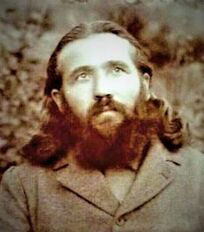 By M.P. Pellicer | Stranger Than Fiction Stories His name was Francis (Francois) Schlatter, and in 1894 he was a shoe cobbler in Denver earning a precarious living. In the next three years his life took a dramatic turn. He became a renown healer, a hermit and ended up dying alone. 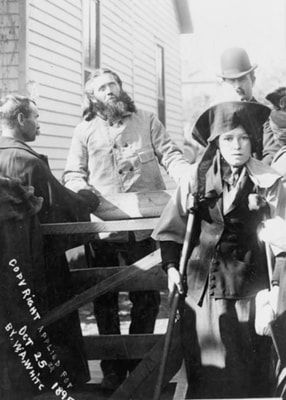 Schlatter blessing handkerchiefs c.1895 Schlatter blessing handkerchiefs c.1895 June, 1897 Two American prospectors were in the foothills of the Sierra Madre on the Puertas Verdes River, when they came across a saddle on a limb in a dead tree high up in a gorge the river ran through. A bleached skeleton was lying stretched out on a blanket close to the tree, and next to it was a copper rod. Piled on the tree were saddle bags, a book, a package of letters bound by a rubber band, six suits of underwear and some blankets. There was also a canteen and a bible with the name of Francis Schlatter written inside the cover. Needles, thread, buttons and other items were found in a knothole in the tree. There were no signs of violence on the skeleton, and the prospectors believed he died of self-imposed starvation, since there was no cooking utensils found amongst his belongings. The site was 35 miles southwest of Casa Grande in the state of Chihuahua. The mayor was notified and the remains were taken to the village. Americans in Casa Grande examined the letters and belongings, and confirmed they belonged to Schlatter. A Mormon cowboy who was among the Americans stated that in November, 1896, Schlatter rode into his camp 50 miles west of Casa Grande on a gray horse. He was unarmed, and was carrying no provisions or cooking utensils. He refused to eat anything and said he was fasting. The cowboy mentioned that Schlatter seemed preoccupied, and the few hours he was staying in his camp he cured his horse of a swelling on the back and forelegs by rubbing his hands over them. He confirmed that the saddle belonged to Schlatter. An Indian told authorities that some months ago, he found a gray horse hobbled where the skeleton was found.  Illustration of Francis Schlatter c.1898 Illustration of Francis Schlatter c.1898 Who Was Francis Schlatter? He was born in 1856 in Alsace, France (present day Germany). He came to the United States in 1884, after his parents died in 1881. He wandered to different cities working as a cobbler. In 1892, he was living in Denver, which is when he received a vision and started to hear "silent voices", which commanded him to give away his tools and begin a pilgrimage toward the Pacific coast. His walking pilgrimage spanned 3,000 miles, and along the way he allegedly healed many people. It was during these times that he became known as the Divine Healer. He was arrested for vagrancy in Hot Springs, Arkansas and he escaped in early 1894 and headed west. He crossed through Texas, New Mexico Arizona and into southern California. He cross the Mohave Desert living only on flour and water. By July 1895, he was seen as a Christlike healer in the the villages south of Albuquerque. He treated hundreds of sick and suffering people. He returned to Denver, where he drew in crowds of tens of thousands looking to be healed at his home in North Denver. He refused payment for any of his services, saying his powers came from Father God. He disappeared on the night of November 13, 1895, leaving a note that said his mission was ended. Nothing more was heard from him until his bones were found in 1897. Later it was learned that he spent three months in Datil, New Mexico, in a ranch belonging to Ada Morley. He dictated his life story to her. She published it as The Life of the Harp in the Hand of the Harper. Prior to his death he was known to go on periodic fasts for days at a time. 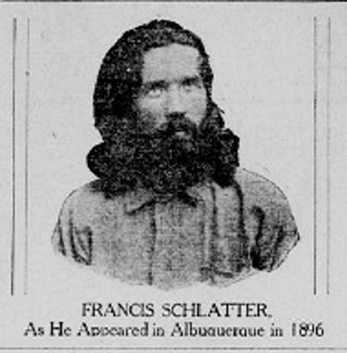 Francis Schlatter c.1896 Francis Schlatter c.1896 The Mystery of El Sanador's Grave After Schlatter's death, and for the next 25 years several men claimed to be Francis Schlatter. They made headlines around the country for their healings. In 1906, Edgar Lee Hewett an archaeologist was conducting research near Chihuahua, Mexico. His Mexican guide pointed to an unmarked grave, and he said that 10 years before he came across the body of a dead man following a blizzard. Based on the guide's description, Hewett believed the dead man was Francis Schlatter who he had met in 1895. He had also witnessed his healing sessions. The guide told him some of the man's belongings were kept by the foreman of Casas Grandes. There he found Schlatter's Bible, saddle and copper rod. In 1922, Hewett returned to Mexico and examined the copper rod once more, which eventually came into the possession of the New Mexico History Museum in the Palace of the Governors. Soon after the report of Schlatter's death there were those who contested if this was the truth. Ada Morley said she doubted the story of the men that found him, since coyotes would never have left a body undisturbed. The only proof the bones belonged to Schlatter were the belongings found with it. 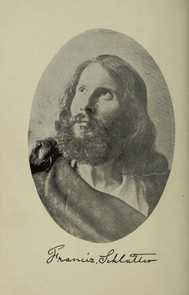 Not everyone believed Francis Schlatter died in 1897. Not everyone believed Francis Schlatter died in 1897. One of the men that posed as Schlatter was Charles McLean, a Presbyterian minister who died penniless in Hastings, Nebraska in 1909. McLean's true identity was cleared up when a family album containing his picture from 1871 was found with his belongings. Inside it was inscribed with the name "Dr. Charles McLean." August Schrader and Jacob Kunze formed a healing team that operated from 1908 to 1917. They were arrested in 1916 for mail fraud and went to jail. Another imposter died in St. Louis in October, 1922. A book that was published in 2016, posits that Schlatter staged his death in Mexico, and returned to continue his ministry through the southern and eastern USA. The author's claim rests mostly on the discovery of a forgotten autobiography in the Library of Congress titled Modern Miracles of Healing A True Account of the Life, Works and Wandering of Francis Schlatter, the Healer attributed to Francis Schlatter, The Alsacian and published in 1903.
0 Comments
Your comment will be posted after it is approved.
Leave a Reply. |
Stranger Than Fiction StoriesM.P. PellicerAuthor, Narrator and Producer Archives
July 2024
Categories
All
|
Stories of the Supernatural
- Stories of the Supernatural
- Miami Ghost Chronicles
- M.P. Pellicer | Author
- Stranger Than Fiction Stories
- Eerie News
- Supernatural Storytime
-
Astrology Today
- Tarot
- Horoscope
- Zodiac
-
Haunted Places
- Animal Hauntings
- Belleview Biltmore Hotel
- Bobby Mackey's Honky Tonk
- Brookdale Lodge
- Chacachacare Island
- Coral Castle
- Drayton Hall Plantation
- Jonathan Dickinson State Park
- Kreischer Mansion
- Miami Biltmore Hotel
- Miami Forgotten Properties
- Myrtles Plantation
- Pinewood Cemetery
- Rolling Hills Asylum
- St. Ann's Retreat
- Stranahan Cromartie House
- The Devil Tree
- Trans-Allegheny Lunatic Asylum
- West Virginia Penitentiary
- Paranormal Podcasts
"When misguided public opinion honors what is despicable and despises what is honorable, punishes virtue and rewards vice, encourages what is harmful and discourages what is useful, applauds falsehood and smothers truth under indifference or insult, a nation turns its back on progress and can be restored only by the terrible lessons of catastrophe."
- Frederic Bastiat
- Frederic Bastiat

Copyright © 2009-2024 Eleventh Hour LLC. All Rights Reserved ®
DISCLAIMER
DISCLAIMER


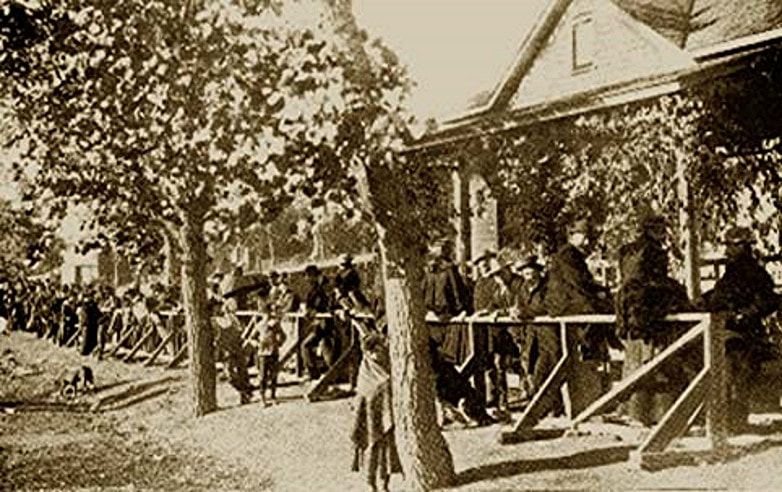
 RSS Feed
RSS Feed
















